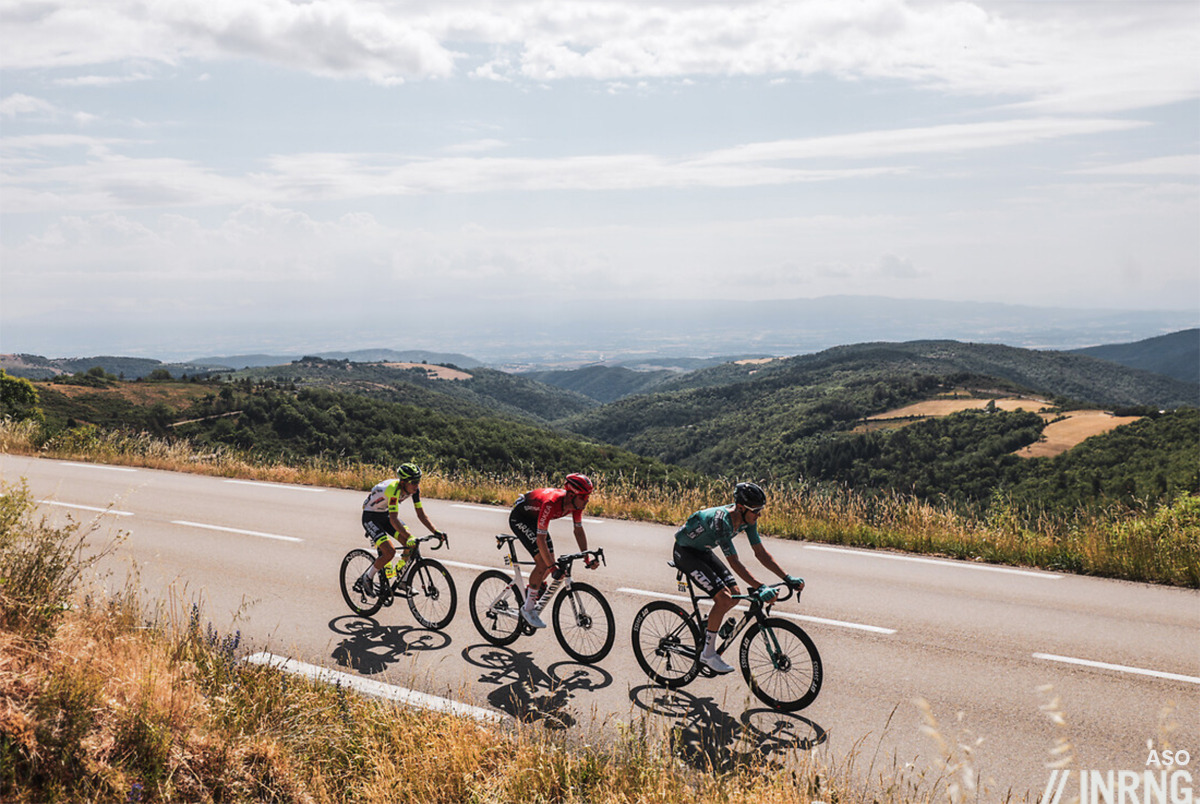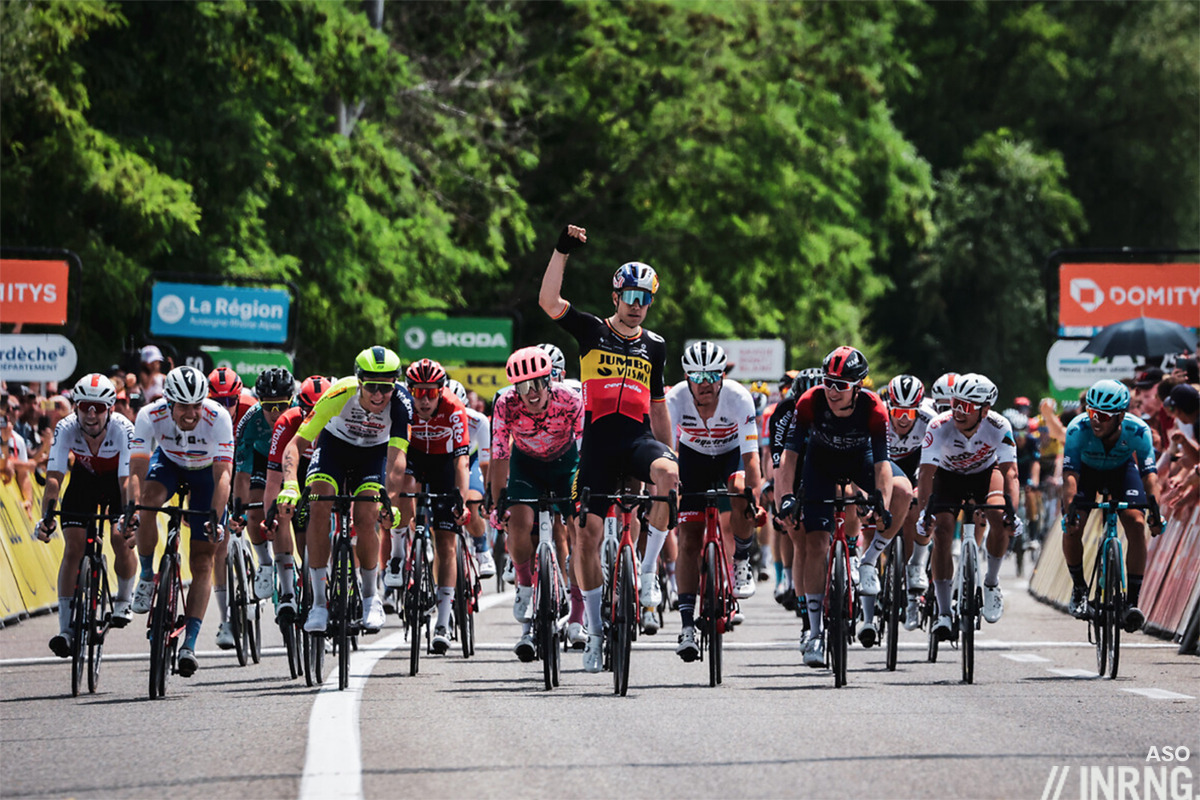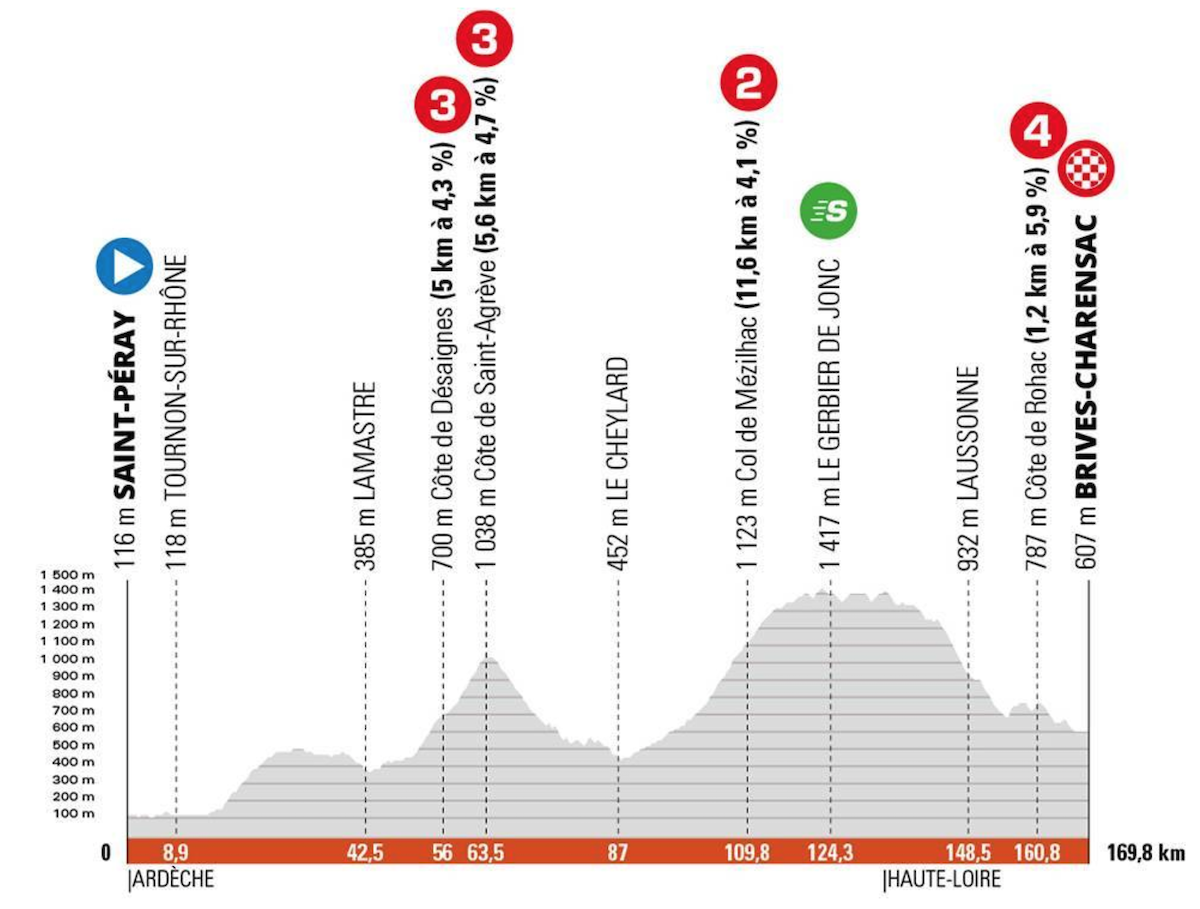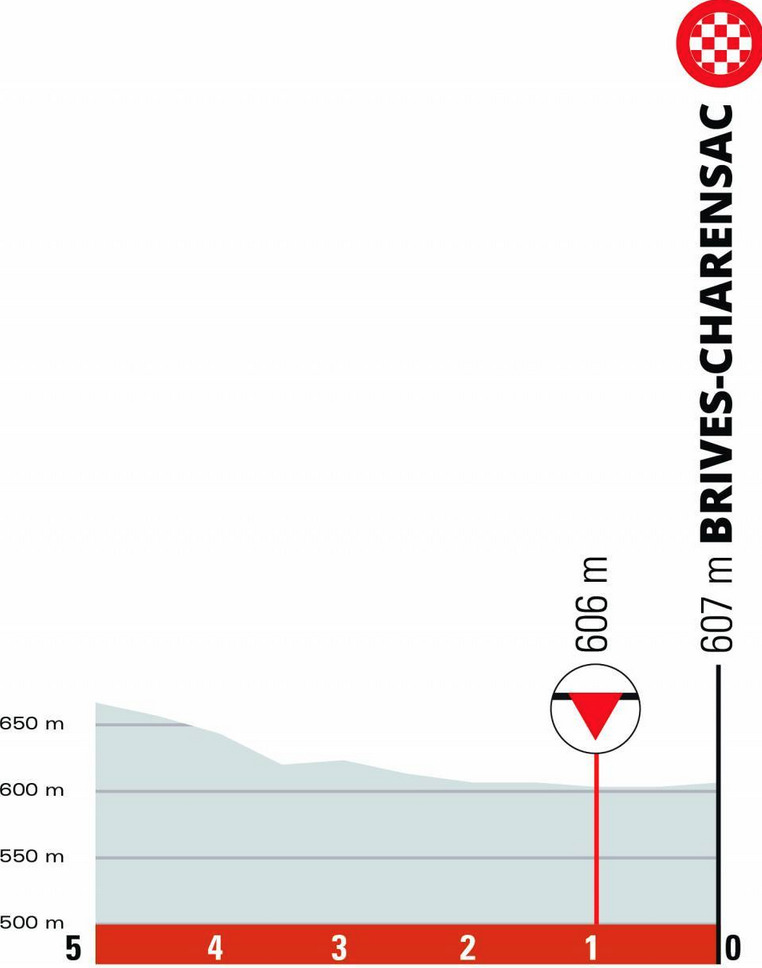A day for the breakaway or another reduced bunch sprint?

Pierre Rolland gathers no moss: thanks to an early attack and some persistent power to hold off an energetic bunch, Pierre Rolland took the mountains jersey for the day. Not the world’s biggest result but 14 years ago he took the jersey as a neo-pro riding for Crédit Agricole – yes, that long ago – and got tipped for the top. Now he’s mulling retirement – “unless a small Spanish team lets me have a nice calendar and be able to ride the Vuelta” – and he’s “saving the furniture” as they say in French for his B&B Hotels team as need any kind of result. Recently team manager Jérôme Pineau reportedly emailed the team roasting his riders for their lack of results; and he told L’Equipe the other day “if I could, I’d buy some out of their contracts so they’d leave“.
Otherwise it was a nicely balanced stage thanks to the likes of Dylan Groenewegen, Phil Bauhaus and J-S Molano getting dumped out the back on the final climb when Trek-Segafredo upped the pace. The dropped riders kept chasing, and with Bike Exchange calling back riders they got to within 30 seconds to supply some suspense. But they couldn’t get closer.
With around 3km to go Ineos vanished from the front of the bunch but soon Michał Kwiatkowski was towing Ethan Hayter back into place. Did this effort cost him the win? Put another way, Wout van Aert was always in position even if he had to send his leadout rider Christophe Laporte to close down a late attack from Rémi Cavagna. The Belgian champion won almost as expected.

The Route: 170km and 3,000 of vertical gain, the stage is defined by the long, gradual climbs of the Ardèche mountains. The Col de Mézilhac is listed as 11km but it’s really a 22km climb from Le Cheylard via the Col de Joux but it’s gentle and only reaches 5-6% for several kilometres before the top. It’s followed by some lumpy roads, ideal terrain to leave the sprinters floundering.
The late climb to Rohac is different, it’s short and has a sting in the tail with a small “wall” section at the top as it enters the village. Just 9km from the finish it’s a possible launchpad for a late attack.
The Finish: flat but twisty, it’s along the right bank of the Loire river, then left onto the bridge across for the flamme rouge, then a sharp left off the bridge, leading to a sharp right turn and another right onto the 500m finishing straight. It’ll be hard to make up ground in the final kilometre.
The Contenders: a replay of yesterday’s stage? The long Col de Mezilhac’s the perfect place for teams to up the pace and drop the sprinters over the top so a rematch between Wout van Aert (Jumbo-Visma) and Ethan Hayter (Ineos) is likely.
One difference is that yesterday BikeExchange rode on the front for the middle of the stage, they’re unlikely to try it today so this gives the breakaways more of a chance. Another is that Trek-Segafredo did much of the work to drop the sprinters yesterday and Jasper Stuyven was seventh, respectable but they’ll be asking if they try the same again, so this suits the breakaway again too.
| – | |
| Wout van Aert, Ethan Hayter | |
| Madouas, Bagioli, Battistella, Skujiņš |
Weather: sunshine and clouds, 27°C.
TV: the stage starts at 12.25pm and the finish is due at 4.40pm CEST.
Guide touristique: the race passes the Gerbier de Jonc, a big cone-shaped peak but it’s not volcanic. It’s famous in France as the source of the river Loire, France’s longest river at just over 1,000km.
Guide politique: the Dauphiné race took its name from the Dauphiné Libéré newspaper, a newspaper from Grenoble and local to the Alps, the Dauphiné being an old province in the Alps. The paper’s still going strong – with a strong cycling section that covers everything from village races to the World Tour – but the paper stopped organising the race and in 2010 ASO took it up and it’s gradually become the “Tour of the Rhone-Alpes-Auvergne” region, a much bigger area than the old newspaper’s circulation. Which explains why the race now ranges across a much larger area than a few years ago. Coincidentally the head of the Rhone-Alpes-Auvergne region used to live in Brives-Charensac, the town of today’s stage finish, and he is mayor of the next town over, Le Puy. So the race will continue to tour the whole region and perhaps it’s even time for a name change to reflect the bigger area?



It seems as though cycling owes everything to the newspaper business!
Newspapers were the supportive media to build so many euro road races.
American gravel racing, at the pro level for sure, is social media’s darling.
Cycling has such great stories and images. Media can’t resist.
For sure. The irony now is that sport has become bigger than the media, ASO’s cycling business is surely worth more to the Amaury family than the newspapers it owns; organising the Giro, the UAE Tour etc is worth more to RCS than writing about it in La Gazzetta and so on. But it’s not all so old fashioned, the early season Tour de La Provence was created a few years ago by the newspaper La Provence.
Another irony is that, while cycling may owe much to newspapers, that debt goes in both directions. It wasn’t just the Tour de France that was created specifically to increase newspaper sales and broaden the readership pool. Apparently many one-day races that preceded the Tour were also created to increase sales of the newspapers that created those races, and after the success of the Tour it appears it became SOP in many regions.
In one article I read it suggests that newspapers sponsoring races led to the road cycling model we have now. Velodromes and race tracks were already very popular and lucrative, so much so that if a newspaper sponsored or created a race at such a site they’d have to share control of the race with the owners of the velodromes. Putting races on public roads gave the newspaper complete control, plus the race routes could be arranged to maximize their reader’s interest and to potentially broaden their subscriber base.
As someone coming back to following the sport after a long hiatus (thanks, Dr Ferrari!) the Dauphine going as far west as the Rhone — never mind crossing it — seems somehow … wrong.
For the GC battle i would expect a team like jumbo to consider letting a break go in order to reduce the workload for the team before bigger stages. But its jumbo and i doubt they will let the leaders jersey and stage win go without a fight because they always tend to expend their energy this way when Roglic and WVA are in the lineup. So i expect a sprint finish with either most of the peleton or a reduced sprint.
Jumbo and ineos must have got out of the bed on the correct side yesterday to have trek set them up like that.
I did not get Bike exchange on the climb at all. Groenewegen dropped with nobody around him. Belatedly one rider came back and then later a few more. They still had 2 in the peleton including one who attached on a hill who did not drop back until a bit more than 10 km to go. They should have had the entire team around Groenewegen before he dropped. They got so close it probably would have made the difference.
To be fair, Ineos and Jumbo did help Trek out a little, with a rider from each giving a turn on the front.
Your point about Jumbo-Visma and possibly conflicting goals in GC and points for van Aert is a prescient one I think though.
It’ll be interesting to see if a breakaway is given any leeway today, I suspect not however.
But projecting ahead to the Tour in July; if van der Poel is on for the Green Jersey he could take WvA and Jumbo-Visma to some very uncomfortable places if he goes in moves, a la Sagan, in the search for points. Even of the intermediate variety.
The Dutchman has his own patent on unconventional riding, never mind Pogacar, and can really throw a spanner in the whole race’s dynamics potentially – will he be allowed in a breakaway, will that breakaway be given time, who chases it down etc etc.
Smart riding by Jumbo-Visma yesterday and they have the firepower to batten down a week-long stage race like this.
I’m not sure about a 3 weeks Grand Tour though, especially putting Pogacar and van der Poel in the mix.
Things could get very messy for them if they are determined to try for both green and yellow jerseys?
I think you’re right on about the potential for things to get messy of TJV when it comes to going for both jerseys. I’ve mentioned here before that I think DQS and Cavendish made a key strategic error in going for both sprint wins and the points jersey at last year’s tour. As Sun Tsu wrote, “Never risk the necessary for the desirable.” It was desirable for Cavendish to win the jersey, but the paramount goal was to set a new record for TdF stage wins. His palmares were not meaningfully enhanced by a second green jersey, and he and his team could have used every last ounce of energy on that final stage, energy that was clearly expended going for intermediate sprints.
A first points jersey will definitely be a feather in the cap for WvA, but if there is any question that said pursuit compromises Roglic finally taking the GC win then from the team perspective it will be a huge embarrassment. We already have examples of the team leaving Roglic alone at the Tour, at great cost, to pursue secondary goals.
If Jumbo said -forget GC in TdF – that’s too much work and might still lose to Pogacar – and just went for stage wins – I wonder how many they could win. A lot would be my guess.
I’d put the over-under at 5 stages.
Prediction spot on yesterday, today’s choices seem reasonable too though maybe the break has a bit more of a chance.
Slight typo in The Route section.
The late climb to Rohac’s different.
Should be: Rohac is different?
Que?
Neither a typo nor an error, perfectly correct. (it’s = it is)
Clearer as “Rohac is” than “Rohac’s” all the same.
I’m really baffled by INEOS tactics to go all-in for Hayter. I know he’s British, so it’s natural to support a domestic rider who packs a good sprint and can time trial well, but at the same time it could be productive to have a second option in Kwiatkowski, who has a proven track record in the same areas and can sustain the tempo on longer climbs. One argument for utilizing him as a road captain may be for saving his legs for the Tour.
“Saving the furniture”: didn’t know it was a saying in French. It’s also one in Dutch (de meubelen redden).
sauver les meubles = save whatever is important and can be carried away (moveable? mobile?), e.g in case of fire. Not necessarily furniture, even though that’s the modern meaning of the word.
I wonder whether this terminology dates back to the aristocratic medieval practice of moving around between residences, but taking all your furniture,,wall hangings and linen with you? Carts piled high with stuff continually on the move around the countryside. So the person who sells residences is a facilitator of the unfurnished.
Likely from when a house was burning, people could limit their losses by rescuing anything they could.
Pierre Roland in the break for KOM points, and then his team mates to attack at all many of strange places to get noticed (after the TV coverage starts of course) and maybe a contract for next year? Otherwise the profile makes it seem a lot harder then it is (though if this was the Tour, I’d bet on Roglic having a dig on the last little bump) – could well be déjà vu all over again.
Stuyven was sixth, not seventh.
Hayter seems somehow incapable of understanding the importance of good positioning. He has been seen bringing up the rear of the bunch for Ks upon Ks.
Shame that someone with such undoubted talent seems incapable of understanding the importance of correct placing/positioning.
Are you sure it’s his lack of understanding? I can’t imagine that he hasn’t been told this many times, and surely his DS is chatting away in his earpiece with all kinds of sound advice. Perhaps he is uncomfortable in the argy bargy leading up to the last few kms, or perhaps he’s tried it the conventional way and it hasn’t worked as well for him.
Never understood how an Omnium and Madison champion could be uncomfortable in the bunch but it does seem to be the case.
Yeh, he finds the argy-bargy challenging. Thomas and Rowe have said as much on a number of occasions on their podcast.
What was Benoot doing today?!?
Saving himself for today’s massage?